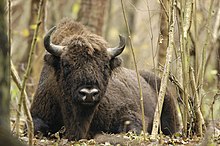International Society for the Conservation of the European bison
The International Society for the Conservation of the Wisent is a former association for the conservation of the last European bison that still existed after the First World War. As a result of the work of the society there are now a total of 3,500 bison, some of which live in wild populations. The best known and oldest free-living populations can be found in the Białowieża National Park (Poland and Belarus).
Foundation and original goals
The International Society for the Conservation of Bison was founded on August 25th and 26th, 1923 in Berlin. Numerous experts joined the company, including Hermann Pohle , Max Hilzheimer and Julius Riemer . The aim of the society was an internationally coordinated cooperation for the conservation of the bison, which is directly threatened with extinction . The last wild bison in the Caucasus was shot in 1927. The first goal of the society was to record all living bison, on the basis of which one could begin with conservation breeding. The society, whose first chairman was the director of the Frankfurt Zoo , Kurt Priemel , joined several private individuals and institutions, for example the "American Bison Society", based on the model of which the International Society for the Conservation of Bison was founded. The main members, however, were the Polish Hunting Association and the Poznan Zoological Garden, as well as a number of Polish private individuals. They were also the first to provide substantial funds to purchase the first bison cows and bulls. The stud book was published in the company's annual report from 1932. Already at this early point in time, a distinction was made between the lowland line with pure-blooded bison of the subspecies Bison bonasus bonasus , the lowland-Caucasus line , in which the bull Caucasus as the only representative of the Caucasian wisent ( Bison bonasus caucasicus ) played a role as a sire. The so-called Pleß line with bison from the forests of the Principality of Pleß was also recorded at the beginning. Erna Mohr , who also played a key role in the maintenance of Przewalski's horses and who published the stud book in 1933 and 1937 , also became a member of the society .
Synchronization in the time of National Socialism
While Priemel aimed at a slow increase in the bison population while keeping the breeding line pure, Lutz Heck planned to suddenly increase the bison population in his own breeding project in Munich from 1934 by crossing American bison. In this he was personally supported by the then Reichsjägermeister Hermann Göring , who u. a. hoped for game that could be hunted. Lutz Heck promised his powerful supporter in writing: "As surplus bulls will soon be set, the bison hunt will be possible again in the foreseeable future." Hermann Göring himself took over the patronage of the "German Student Council of Wisent Breeders and Hunters", which was founded at the suggestion of Lutz Heck. Kurt Priemel, who in the meantime had to give up his post as president of the "International Society for the Conservation of Bison", warned in vain against a "muddling". This criticism prompted Lutz Heck to threaten Priemel by announcing that Göring would take action against Priemel if he continued to oppose his plans for an intersection. Thereupon Priemel was banned from publishing in relation to bison breeding and also the keeper of the "International Society", Erna Mohr, had to hand over the official studbook in 1937. With this, the older society was factually incorporated into the newly created "Fachschaft" and thus brought into line. After the Second World War, only the pure-blooded bison in the Springe Wildlife Park near Hanover were recognized as part of the international herdbook.
literature
- Original maker undesirable. Berlin Zoo. In: Der Spiegel from June 23, 1954.
- Frank G. Wörner: THE WISENT - A Success of Species Protection: Notes on the Rescue and Return of a Giant. In: Publications of the Niederfischbach zoo together with the regional nature conservation association Ebertseifen Lebensräume eV, 2006.
- Małgorzata Krasińska and Zbigniew Krasiński : The wisent . Die Neue Brehm-Bücherei Volume 74, Westarp Wissenschaften, Hohenwarsleben 2008, ISBN 978-3-89432-481-0 .
- Irina Steinmann: Nils Seethaler did research on Julius Riemer . In: Wittenberger Sonntag from May 10, 2019.
Individual evidence
- ↑ Nils Seethaler has researched Julius Riemer. In: Wittenberger Sonntag / Freizeit Magazin. FIW mbH & Co. KG, May 10, 2019, accessed on August 12, 2019 .
